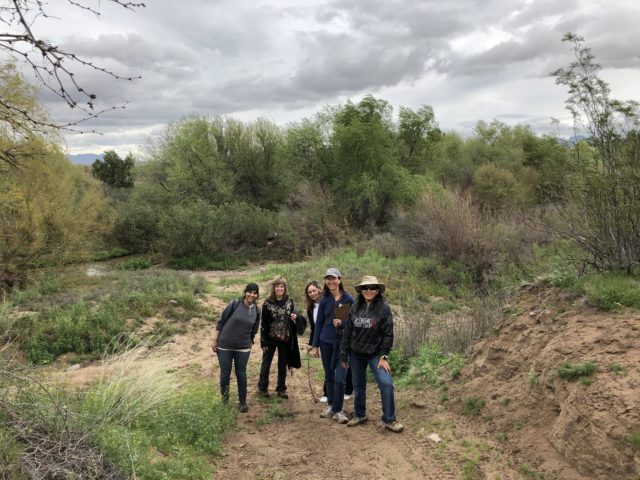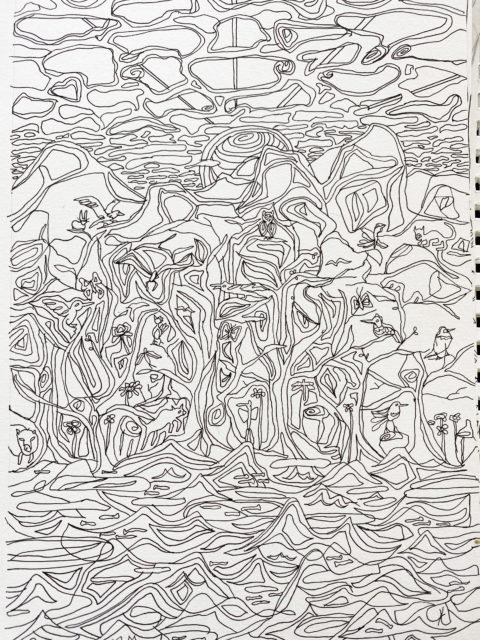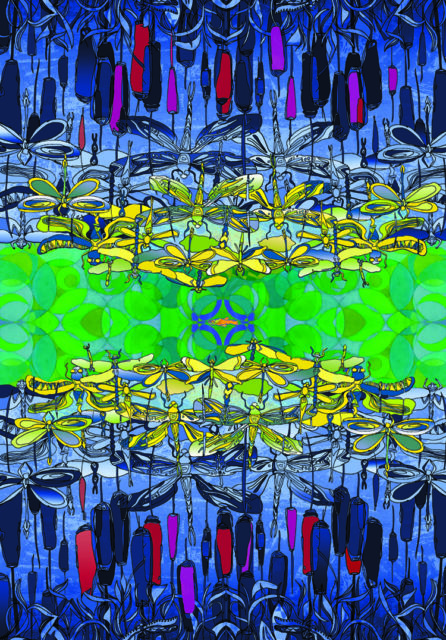“This is what happens when a stretch of river comes back to life. There are many benefits. We should aspire to more wet stretches.”
-Lauri Kaye, Tucson artist
Nature has inspired human creativity throughout our history. What is it about the great outdoors that makes us want to record it, to try and capture the feeling of being somewhere special? Why do we identify with places so strongly? At Sonoran Institute, we think that art provides, or at least approaches, an answer to that question. In this case, art helps tell a story.
The genesis of popular Tucson artist Lauri Kaye’s recently completed portrait of the Santa Cruz River was, like many of her pieces, a result of a spontaneous, unplanned meeting. In this case, a neighborhood social gathering, attended by a Sonoran Institute staffer.
Known for her 50-plus series of “Tucson Portrait Stories” that celebrate the history and culture of the Old Pueblo, Lauri gets most of her ideas by meeting people, sometimes on the street or at events. She is drawn by personal stories that speak to broader community concerns or whose contributions are part of what makes Tucson special.
Lauri admits that before learning about the Sonoran Institute’s work on the Santa Cruz she didn’t know much about the river; mostly, that it was dry. But that chance encounter led her to do some research and agree to join us on a field trip.

“I realized that the Santa Cruz is why Tucson exists, why we live here,” says Lauri.
She also learned that there is a diverse group of organizations, including the Sonoran Institute, that are working together to bring back flowing stretches of the river. “I’m drawn to people who are passionate about what they do. There’s so much going on around the Santa Cruz. I wanted to capture that energy and collaboration, which I see as the essence of Tucson.”
Lauri did some initial sketches for her portrait of the Santa Cruz, based on her research. The organic, winding lines of the sketch weave into a river scene teeming with life. The outlines of light reflecting on water blend into fishes; animals, flowers, and trees merge; sky, mountains, and water all run together. The unity of form and line mimics the interconnectedness of nature itself.

She knew her final piece would feature the return of the endangered Gila topminnow, but dragonflies? That had not occurred to her until she heard Dick Thompson, from Tucson Water, speak during the field trip. Dick shared that within a day of water replenishing the river through downtown, there had been an explosion of dragonflies. Lauri decided she needed to capture this dramatic response to a new wet stretch of river.
Lauri also wanted to feature cattails in her portrait. Cattails were one of the first plants to colonize previously dry stretches of river; their iconic shape conjures up wetland landscapes across the country.
This trio of elements—the Gila topminnow, dragon flies, and cattails—harkens back to Lauri’s original “land, water, and sky” theme for the piece. But one other unique element was added.
“I wanted to capture the reflective nature of the river, so I created a symmetrical piece,” with all three elements mirroring each other. The final piece features a vivid ribbon of green through the center, a singular suggestion of a fish floating meaningfully in the center. On each side, a horde of dragonflies of all kinds drives towards the center, full of energy, giving way to a field of cattails rendered in cool, dark blues and purples.

When asked what she hopes others will take away from her Santa Cruz portrait, Lauri was succinct, “This is what happens when a stretch of river comes back to life. There are many benefits. We should aspire to more wet stretches.”
At Sonoran Institute, we believe that the inspiration people get from the natural world is one of the many reasons why it’s important to protect open spaces and make sure all people have access to them. Art is a fantastic tool to not only share what we love, but to send a message, too. Through art, we can inspire others to protect the natural wonders we all treasure.
Blog post by: John Shepard, senior director of programs. To see and learn more about Lauri Kaye’s “Tucson Portrait Stories, visit Create for the People. Lauri donates sales of select artwork to local nonprofits.
